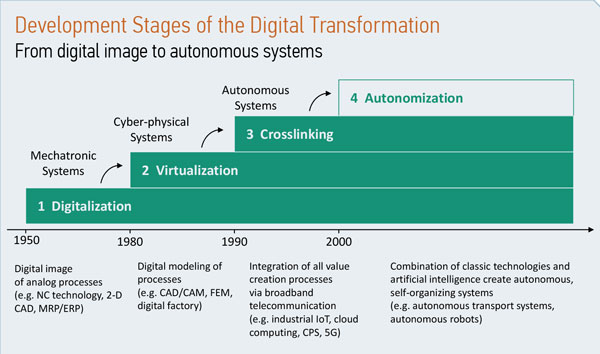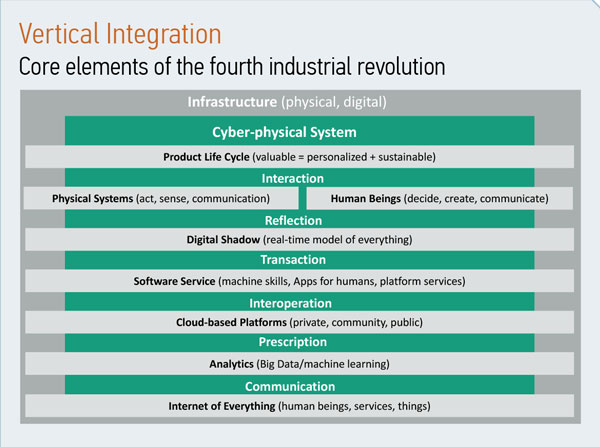IoTT : Transforming the Business Ecosystem
Current trends in production such as digitization, including the shift to mass personalization, lead to significant changes in manufacturing. The stages of digital transformation in the framework of the Industry 4.0 concept have a long history starting with mechatronic systems leading to cyber-physical and eventually autonomous systems to the final degree of autonomization. The traditional automation pyramid is thus dissolving.
The revolutionary aspect of Industry 4.0 is not digitization itself, but the ability to network technical systems in real time. Machines, sensors, tools, orders and people can communicate via the Internet without time delays or barriers. Cyber-physical systems (CPS) are the core technology of Industry 4.0. The key structural elements include an innovative user interface for integrating human beings into the process, the digital shadow (a virtual real-time image of reality) and software services which generate added value. It also incorporates cloud-based platforms which support communication, a life cycle environment for physical systems and software services and analytical tools based on big data and machine learning. CPS use data from the Internet of Everything – the Internet of people, things and services.
Real-time integration is the key
The development of digitization started with mechatronic systems in the 1950s including, for instance, digital imaging of analogue processes or computerized numerical control (CNC) technology. In the 1970s, it was joined by computer-aided design (CAD) and enterprise resource planning (ERP) and others. The first tentative steps towards developing Industry 4.0 can be found in the computer-integrated manufacturing (CIM) strategies of the 1980s. However, in those days, the necessary technologies were not available and there was a widely held belief that centralized controls were essential. At that time, designers envisaged humans being removed from the factory altogether. Then, the era of virtualization began. Cyber-physical systems were developed and the integration of all value creation processes via broadband communication was realized with the help of cloud computing and the industrial Internet.
The last decades witnessed an unprecedented acceleration in the development of new digital technologies: the Internet, WLAN, high-performance computing and finally big data. These technologies have been the key to creating completely new opportunities in networking and data processing, and thus facilitating the so-called Fourth Industrial Revolution.
Since the 1990s, the degree of networking has grown at a breath-taking rate. Trends such as the Internet of Things (IoT) or app- and cloud-based services have broken way out of the information and communication sector into the world of production and are adding still more fuel to the networking boom. These achievements would be impossible without the rapid growth in computing power, continuously expanding Internet bandwidth and the greater mobility of the technologies and user devices. The final step of crosslinking-yielded autonomous systems leads to increasing autonomization. This will be achieved through the combination of classic technologies and artificial intelligence which create autonomous, self-organizing systems (e.g. autonomous transport systems, autonomous robots).
The capabilities offered by IT – communication and data storage using Internet technologies as well as the exponential increase in computing capacity – are truly transforming the digitization evolution into a revolution.

The capabilities offered by IT are truly transforming the digitization evolution into a revolution.
Cloud-based platforms
Cloud-based platforms offer applications that run in the cloud, or use services provided from the cloud, or both. There are various kinds of platforms today. IT-oriented production platforms take their origin in IT. Many services and apps exist already. The usual business approach/model is Pay-per-Use for everything. But there are no manufacturing applications. In this environment, big data will be expensive for the user.
Also in business-oriented platforms there are many apps already. The service shops offer internal and external services. Some of the apps could be used in manufacturing and some platforms are available as private clouds. Industry-oriented platforms, however, are at a nascent stage of development.
New imperatives of value definition
The value of a company today does not necessarily depend on resources, namely the number of employees, the machines and plants or the produced and sold number of products. It depends on customer access. The more customers are being integrated via business platforms, the more the value of a company rises. Data is the gold of our business ecosystems.
These examples also show that the characteristics of digital business models are low fix costs (XaaS), because time is money. The marginal costs are close to zero and the revenue develops after generating a lock-in effect by gaining a critical size.


Use and benefits
The advantage of Industry 4.0 is that it offers versatile, highly flexible systems which make it possible to transfer value creation to the location where it can best take place. This reduces complexity costs and generates new potential for improving efficiency. The overall system of objectives for value creation – in terms of time, costs, quality, flexibility and sustainability – remains unchanged but the requirements rise in each individual area. Industry 4.0 extends the scope of solutions used in designing the economic and sustainability aspects of value creation systems – from the process to the business ecosystem. This perfectly integrates all the value creation partners and the end customers. This capability is new. Networking based on platforms, which permit both horizontal and vertical integration, can, therefore, be used to generate and distribute specific tasks or machine functionalities within this economic ecosystem.
Advantages of Industry 4.0
Four core theses for the value creation model of the future describe the advantages of Industry 4.0:
Optimum distribution of value creation processes in an economic network. This connects all the value creation partners, suppliers and customers in a structure with minimal hierarchies and leads to low complexity costs and, thus, a higher total margin.
Optimum distribution of functionalities (services) in the cyber-physical system architecture. This leads to scale effects and greater adaptability of functions throughout the life cycle of technical systems.
Forecasts and future scenarios based on big data and the digital shadow of reality. This provides the foundation for high productivity and agility in complex value creation systems.
Adaptive, self-teaching human-machine interfaces. These integrate employees into the process and eliminate waste. They also ensure full acceptance in the work system and create the basis for agile, robust value creation systems which are capable of learning.
New technologies and business models thus enable suppliers, service providers and customers to take on new roles and collaborate in the value creation process. The product can become an information carrier and, therefore, support every phase of its life cycle autonomously. This is known as digital product memory. It also opens new horizons for designing and optimizing the value creation process. It offers the potential for major savings in almost every area of value creation.
The use of real-time stock data and other information throughout the supply chain can reduce stock costs by up to 40 percent. Production and logistic costs can also be reduced by 10-30 percent by using smart wearables at production workplaces or analytics to boost overall equipment efficiency. Complexity costs are usually indirect costs and offer even greater potential savings. They can be reduced up to 70 percent by integrating the customer of the product into the value creation system in each case, using comprehensive service products and decentralization, and removing hierarchies from value creation responsibilities. In this “prosumer” model, the customer is not just a consumer but also one of the producers. He performs tasks which used to be the responsibility of the manufacturer. This offers further cost savings.
Companies can download CAD software, design the part they require and then order it at the click of a mouse. Everything as a Service, the XaaS concept, is also leading to the emergence of “complexity bundlers”, which focus on one topic and develop special expertise in that area. They offer services to match, such as procurement platforms that select the best quality and best value suppliers. This cuts the manufacturer’s workload without compromising on the scale effects.
Step-by-step, the digital transformation is breaking down the Taylorist principle of separating labor and knowledge. In future, knowledge will be transferred directly to the production line. Employees will once again become competent to make decisions in every area – using assistance systems where necessary – and concentrate on high-value tasks such as decision-making and design. Seen from this standpoint, Industry 4.0 will bring back the expertise of the engineers directly into the value creation process and improve the status of production workplaces.

Industry 4.0 will bring back the expertise of the engineers directly into the value creation process and improve the status of production workplaces.
Challenges of dealing with big data
In the framework of Industry 4.0 and the digitization of value creation within platform-based ecosystems, there is a change of perspective, because of the use of big data. Complicated contexts are being systematically analyzed through root cause analysis. The complicated network is divided in small entities and correlations are being examined. There is only random sample analysis and thus a deductive approach. The question behind is “why?”.
In contrast, complex contexts are no longer being analyzed with regard to their causes. This way, correlation replaces causality. Regularities are being derived from all available data, because pattern recognition is available, e.g. customers behaviour patterns. The complete data screen is being analyzed in an inductive approach. The question here is “what?”.
The Road Ahead
Cyber-physical systems connect the IoT with people and new tools, resources and services in production systems – in real-time. This lies at the heart of the Fourth Industrial Revolution, in whose context value creation is platform-based and integrated in business ecosystems. Today, the market is ready and consumers buy eagerly.
Technologies revolutionizing production systems
Horizontal networking :
- The use of the Internet of Things (IoT) and Services in value creation systems – across different companies, at the same stage of the value creation chain, from the customer to the supplier.
Vertical integration :
- Changing machine architecture from a mechatronic system to a cyber-physical system. Machines or tools then communicate with other CPS in the Internet – vertically within a company, on a technical level from the sensor to the decision-making system on the top floor.
Real-time optimization of complex value creation systems :
- This is done by processing big data and using it to make predictions about the future.
Economic Benefits of Industry 4.0
New innovation
- Disruptive business models
- Customer-centered innovation processes
- Open X (innovation, funding, creation, source etc.)
Personalization
- Complexity as competitive factor
- Personalized products and services
Regionalization
- Frugal products
- Local value creation
- Micro factories
Flexibility
- Decentralized work systems (swarm)< /li>
- Plug and produce (cyber-physical systems)
Cost optimization
- Variabilization of costs (XaaS)
- Reduction of complexity costs (prosumer, platforms, communities etc.)
- Data-based productivity optimization (big data)
Sustainability
- Savings in energy and material (smart grid, zero waste etc.)
- Resource protection / environmental friendliness (sharing economy)
Staff
- Better working conditions (personalization of work places, reduction of waste, appreciation of competences)
- New working-time models (work-life integration)
Author
Prof Dr Thomas Bauernhansl
Director - Fraunhofer Institute for Manufacturing Engineering and Automation IPA and the Institute of Industrial Manufacturing; & Management IFF
University of Stuttgart
thomas.bauernhansl@ipa.fraunhofer.de





 Facebook
Facebook Twitter
Twitter Linkedin
Linkedin Subscribe
Subscribe